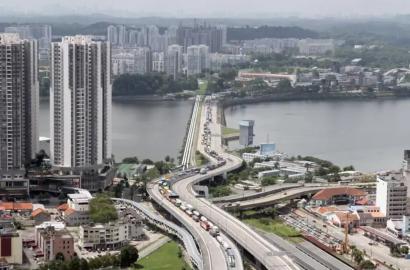Explore Our Exciting New Property Listings Now Available in Prime Locations!
As Malaysia’s real estate industry continues to evolve, staying ahead of emerging trends is crucial to driving growth and overcoming challenges. This was the main message delivered by speakers at the 32nd National Real Estate Convention (NREC 2025).
With the theme “Fostering Innovation for a Sustainable Future: Bricks, Blueprints and Beyond”, the convention gathered industry leaders, policymakers and academicians to explore transformative trends in real estate.
In his welcome address, Royal Institution of Surveyors Malaysia (RISM) president Ahmad Sanusi Che Cob said the theme for this year’s convention reflects the evolving landscape of Malaysia’s real estate sector.
“It goes beyond the tangible elements of buildings and infrastructure, and speaks to the innovations, resilience and visionary thinking that must guide our industry as we navigate towards a more sustainable and inclusive future. Today’s global environment is also about policy, technology, communities and purpose,” he added.
Kuala Lumpur Mayor Datuk Seri Maimunah Mohd Sharif, who officiated at the convention, said: “Kuala Lumpur’s journey is not just about what we build, but also about how we live. Building a smart, sustainable, liveable, lovable and resilient Kuala Lumpur is not merely a policy objective, it is a promise to create communities with a strong sense of belonging and a city that people love.”
Organised by the property surveying division of RISM, NREC 2025 took place on April 17 at the Wyndham Grand Bangsar in Kuala Lumpur. The full-day convention featured five main sessions, with each session comprising up to three individual paper presentations.
Catalytic projects
The first session, titled “Industry Game-Changers in Malaysia: SEZs, Mega Projects & Economic Growth Drivers”, was moderated by Universiti Technologi Malaysia associate professor of property finance Muhammad Najib Razali. It featured three paper presentations, namely “Malaysia’s Smart & Sustainable Financial District” by TRX City Sdn Bhd CEO Datuk Azmar Talib; “Johor-Singapore SEZ (JS-SEZ) — Strengthening Cross-Border Economics” by Iskandar Regional Development Authority (IRDA) director of strategic driver Maimunah Jaffar; and “ECRL: Transforming Connectivity & Regional Development” by East Coast Economic Region Development Council (ECERDC) chief operating officer Datuk Ragu Sampasivam.
The first project discussed was the Tun Razak Exchange (TRX) mixed-use development in Kuala Lumpur. Spanning 70 acres, TRX comprises a shopping mall, a hotel, office buildings, residential towers and a 10-acre public park. Azmar said in his presentation that TRX was designed not only for profitability but also to support Malaysia’s economic growth and elevate Kuala Lumpur as a global financial centre.
“The development has already attracted over RM8 billion in foreign direct investments (FDIs) and created more than 30,000 jobs, and expects to generate 80,000 knowledge-based employment opportunities. The development currently hosts about 50 multinational corporations,” he added.
On what is next for the project, Azmar revealed that the company has received approvals to begin construction of a new office tower that will house PricewaterhouseCoopers Malaysia Holdings Sdn Bhd (PwC Malaysia) as its anchor tenant.
Speaking about the highly anticipated initiatives of the JS-SEZ, Maimunah explained its relationship with Iskandar Malaysia and the Invest Malaysia Facilitation Centre-Johor (IMFC-J). She also outlined the key performance indicators and investment targets for the region.
“For investments, our 2025 target was RM383 billion. But we’ve already surpassed that, reaching RM453.3 billion this year. We’re aiming for RM636 billion by 2030,” she said.
On what makes the JS-SEZ different from Iskandar Malaysia, Maimunah elaborated, “Over the past 19 years [for Iskandar Malaysia], we’ve worked closely with Singapore, although not in a structured format at the government-to-government level. Previously, collaborations happened more at the agency level, between Iskandar Malaysia, IRDA and its counterparts like Enterprise Singapore or the Singapore Economic Development Board. This year [with JS-SEZ], we are moving towards a more structured collaboration.”
She highlighted several goals via the partnership, including improving cross-border mobility and connectivity for people and goods, as well as enhancing economic complexity.
The JS-SEZ is expected to generate 50 projects, 20,000 skilled job opportunities and 7% to 8% of gross domestic product growth in the next five years. Sectors that are expected to set up shop in the region include the artificial intelligence (AI) and quantum computing supply chain; medical devices and pharmaceuticals; aerospace manufacturing as well as maintenance, repair and overhaul (MRO) services; and integrated tourism projects.
Presenting the role of ECERDC in developing the east coast of Peninsular Malaysia, Ragu said, “The East Coast Economic Region (ECER) covers three states [Kelantan, Terengganu and Pahang] and two districts in Johor, which altogether make up about 15% of Malaysia. It has historically been considered a lagging region, but not anymore.”
The east coast, particularly the Kuantan area or Gebeng Industrial Area, is also known as the ECER special economic zone. Ragu said this area has had this designation since 2010.
“One of the key reasons is improved travel convenience. In addition, we now have the East Coast Rail Link (ECRL), which will start from the northern end, from Tumpat, passing through Kuala Terengganu, Kuantan, Bentong and Gombak, and finally down to Port Klang,” he added.
“Kuantan Port is strategically located to access markets in China and the Far East, including Japan and South Korea. So, for industries located in Kuala Lumpur or Selangor, Kuantan Port offers a viable option to export to those markets using rail and sea connectivity. Conversely, you can also bring investments into the ECER and access the Middle East and European markets via Port Klang, using the ECRL.”
Ragu also highlighted that within the ECER, there are several industrial parks developed and managed by the ECERDC, including the Pahang Technology Park, Gambang Halal Park and Kerteh Biopolymer Park.
To further drive tourism in the region, ECERDC is currently studying the viability of developing a recreational vehicle (RV) park in the ECER, he said. These parks will be located near beaches and national parks.

Catatan berkaitan:
The housing and local government minister says the sales and service tax exemption is determined by either the land title or intended use of the property.
Malaysia remains, hands down, Singaporeans’ favourite foreign property location. Besides lower costs, proximity is a major issue here: we have the option to stay in Malaysia and rent out our property in Singapore, or vice versa, as the situation requires....


